Comprehensive Report: Business Problem Solving and Decision Making
VerifiedAdded on 2021/01/01
|12
|4125
|92
Report
AI Summary
This report delves into the intricacies of business administration, focusing on problem-solving methodologies and their practical application. It explores various techniques for addressing organizational challenges, including the analysis of risk factors and abstraction. The report examines the significance of organizational and legal constraints, such as size and interdependence, in the problem-solving process. It highlights the crucial role of stakeholders, including investors and customers, in decision-making and the development of innovative strategies. The report outlines the steps involved in the decision-making process, from identifying the problem to reviewing the implemented solution. It further discusses the importance of continuous improvement, its benefits, and models like Kaizen. The report also addresses the nature, causes, and implications of resource shortages, emphasizing the need for effective action plans and the importance of customer and stakeholder feedback. The content provides a comprehensive overview of problem-solving in a business context.
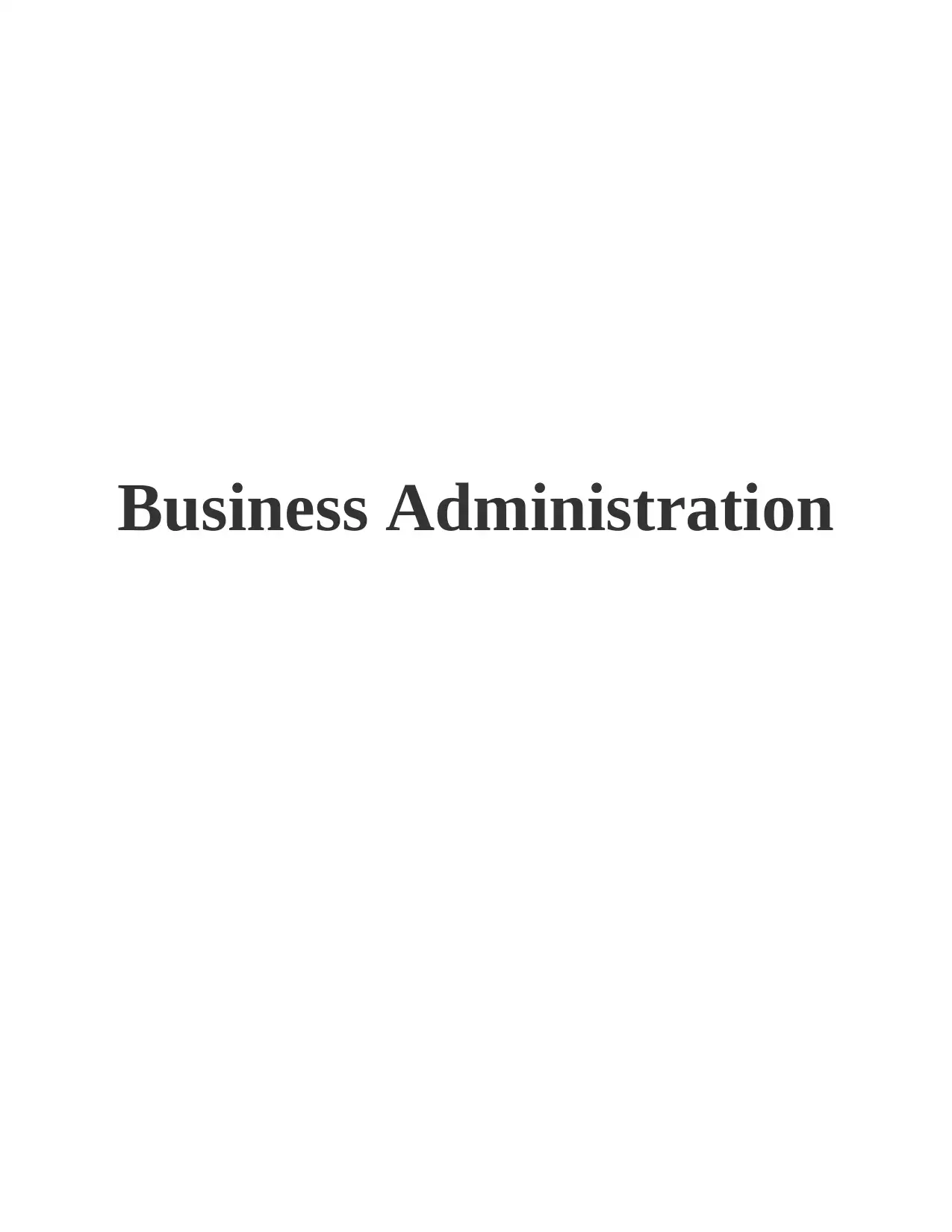
Business Administration
Secure Best Marks with AI Grader
Need help grading? Try our AI Grader for instant feedback on your assignments.
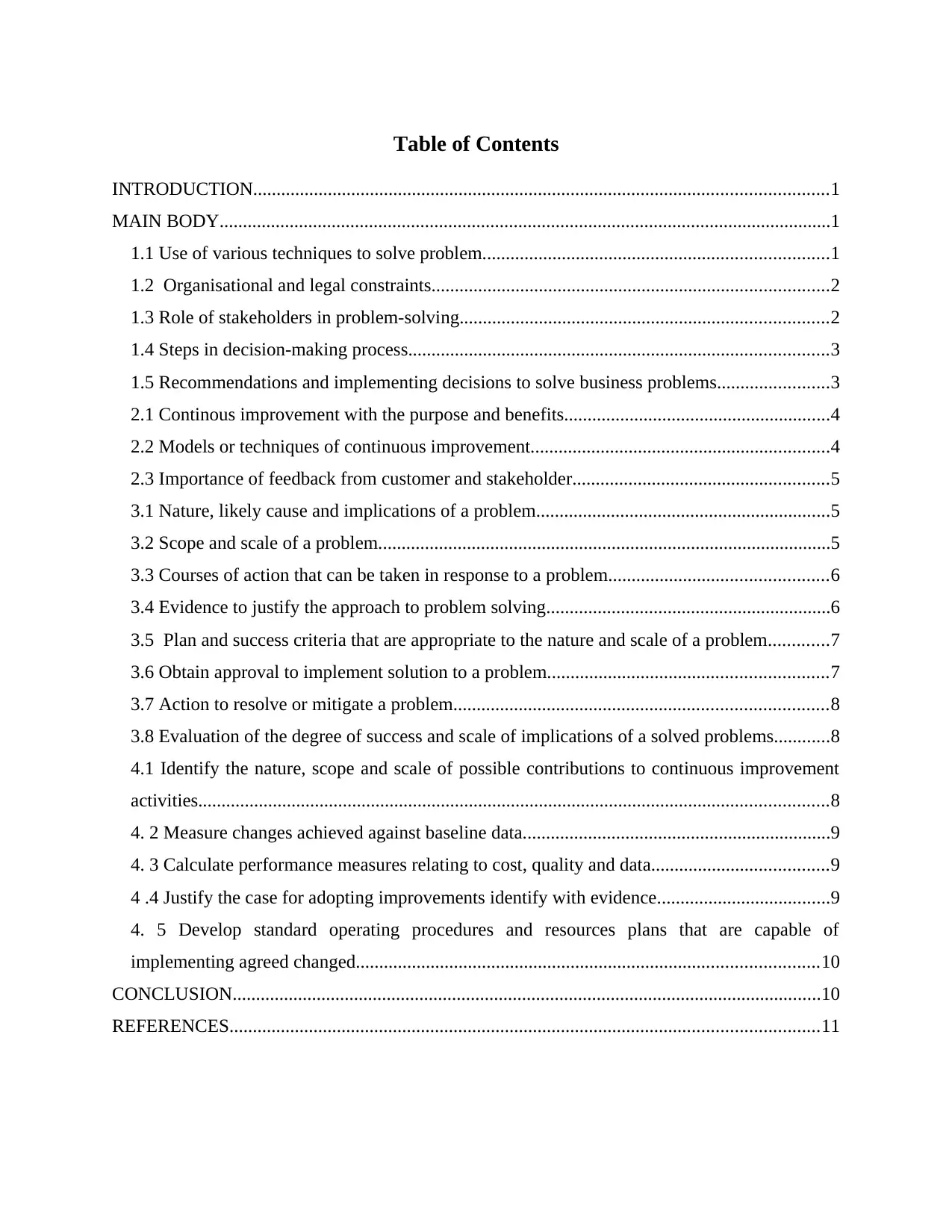
Table of Contents
INTRODUCTION...........................................................................................................................1
MAIN BODY...................................................................................................................................1
1.1 Use of various techniques to solve problem..........................................................................1
1.2 Organisational and legal constraints.....................................................................................2
1.3 Role of stakeholders in problem-solving...............................................................................2
1.4 Steps in decision-making process..........................................................................................3
1.5 Recommendations and implementing decisions to solve business problems........................3
2.1 Continous improvement with the purpose and benefits.........................................................4
2.2 Models or techniques of continuous improvement................................................................4
2.3 Importance of feedback from customer and stakeholder.......................................................5
3.1 Nature, likely cause and implications of a problem...............................................................5
3.2 Scope and scale of a problem.................................................................................................5
3.3 Courses of action that can be taken in response to a problem...............................................6
3.4 Evidence to justify the approach to problem solving.............................................................6
3.5 Plan and success criteria that are appropriate to the nature and scale of a problem.............7
3.6 Obtain approval to implement solution to a problem............................................................7
3.7 Action to resolve or mitigate a problem................................................................................8
3.8 Evaluation of the degree of success and scale of implications of a solved problems............8
4.1 Identify the nature, scope and scale of possible contributions to continuous improvement
activities.......................................................................................................................................8
4. 2 Measure changes achieved against baseline data..................................................................9
4. 3 Calculate performance measures relating to cost, quality and data......................................9
4 .4 Justify the case for adopting improvements identify with evidence.....................................9
4. 5 Develop standard operating procedures and resources plans that are capable of
implementing agreed changed...................................................................................................10
CONCLUSION..............................................................................................................................10
REFERENCES..............................................................................................................................11
INTRODUCTION...........................................................................................................................1
MAIN BODY...................................................................................................................................1
1.1 Use of various techniques to solve problem..........................................................................1
1.2 Organisational and legal constraints.....................................................................................2
1.3 Role of stakeholders in problem-solving...............................................................................2
1.4 Steps in decision-making process..........................................................................................3
1.5 Recommendations and implementing decisions to solve business problems........................3
2.1 Continous improvement with the purpose and benefits.........................................................4
2.2 Models or techniques of continuous improvement................................................................4
2.3 Importance of feedback from customer and stakeholder.......................................................5
3.1 Nature, likely cause and implications of a problem...............................................................5
3.2 Scope and scale of a problem.................................................................................................5
3.3 Courses of action that can be taken in response to a problem...............................................6
3.4 Evidence to justify the approach to problem solving.............................................................6
3.5 Plan and success criteria that are appropriate to the nature and scale of a problem.............7
3.6 Obtain approval to implement solution to a problem............................................................7
3.7 Action to resolve or mitigate a problem................................................................................8
3.8 Evaluation of the degree of success and scale of implications of a solved problems............8
4.1 Identify the nature, scope and scale of possible contributions to continuous improvement
activities.......................................................................................................................................8
4. 2 Measure changes achieved against baseline data..................................................................9
4. 3 Calculate performance measures relating to cost, quality and data......................................9
4 .4 Justify the case for adopting improvements identify with evidence.....................................9
4. 5 Develop standard operating procedures and resources plans that are capable of
implementing agreed changed...................................................................................................10
CONCLUSION..............................................................................................................................10
REFERENCES..............................................................................................................................11
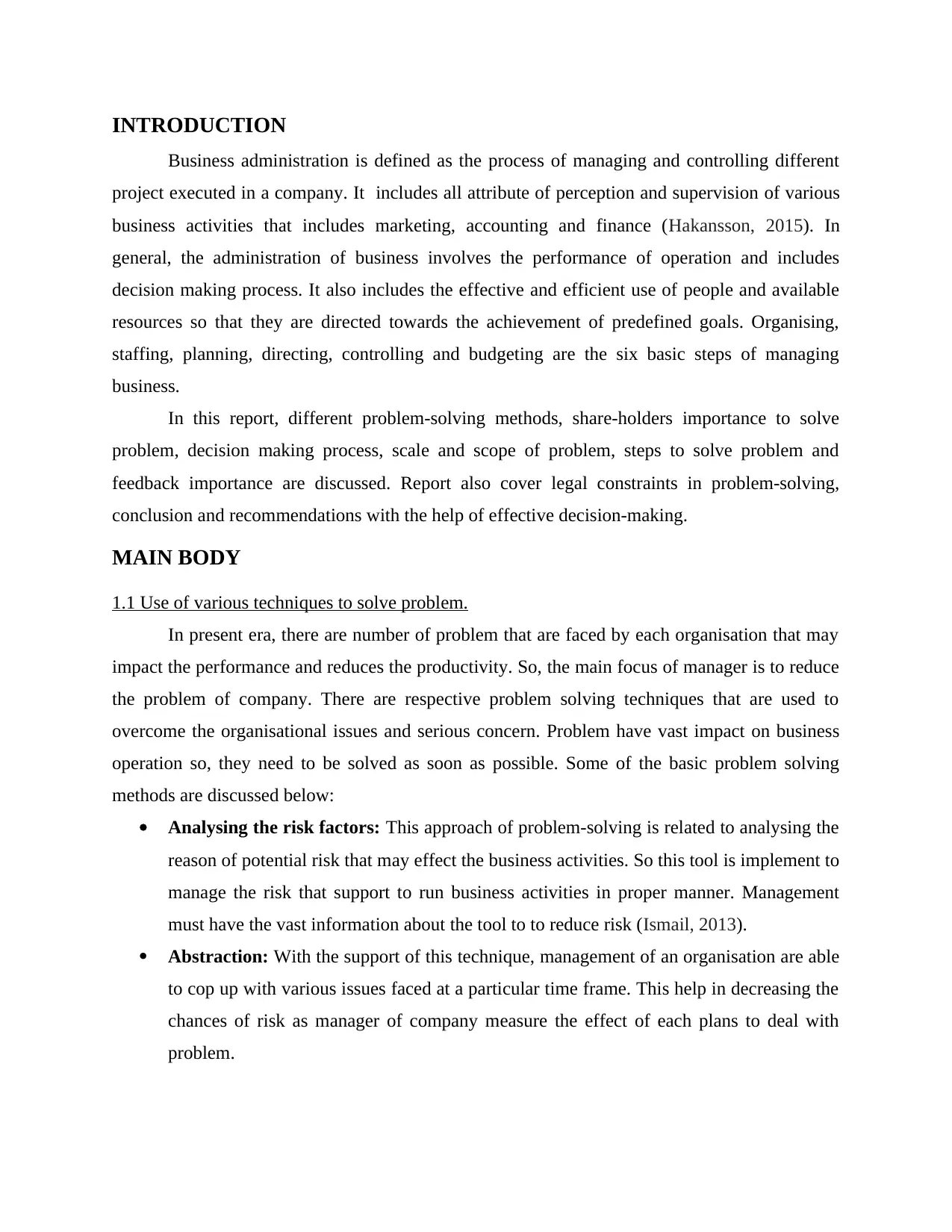
INTRODUCTION
Business administration is defined as the process of managing and controlling different
project executed in a company. It includes all attribute of perception and supervision of various
business activities that includes marketing, accounting and finance (Hakansson, 2015). In
general, the administration of business involves the performance of operation and includes
decision making process. It also includes the effective and efficient use of people and available
resources so that they are directed towards the achievement of predefined goals. Organising,
staffing, planning, directing, controlling and budgeting are the six basic steps of managing
business.
In this report, different problem-solving methods, share-holders importance to solve
problem, decision making process, scale and scope of problem, steps to solve problem and
feedback importance are discussed. Report also cover legal constraints in problem-solving,
conclusion and recommendations with the help of effective decision-making.
MAIN BODY
1.1 Use of various techniques to solve problem.
In present era, there are number of problem that are faced by each organisation that may
impact the performance and reduces the productivity. So, the main focus of manager is to reduce
the problem of company. There are respective problem solving techniques that are used to
overcome the organisational issues and serious concern. Problem have vast impact on business
operation so, they need to be solved as soon as possible. Some of the basic problem solving
methods are discussed below:
Analysing the risk factors: This approach of problem-solving is related to analysing the
reason of potential risk that may effect the business activities. So this tool is implement to
manage the risk that support to run business activities in proper manner. Management
must have the vast information about the tool to to reduce risk (Ismail, 2013).
Abstraction: With the support of this technique, management of an organisation are able
to cop up with various issues faced at a particular time frame. This help in decreasing the
chances of risk as manager of company measure the effect of each plans to deal with
problem.
Business administration is defined as the process of managing and controlling different
project executed in a company. It includes all attribute of perception and supervision of various
business activities that includes marketing, accounting and finance (Hakansson, 2015). In
general, the administration of business involves the performance of operation and includes
decision making process. It also includes the effective and efficient use of people and available
resources so that they are directed towards the achievement of predefined goals. Organising,
staffing, planning, directing, controlling and budgeting are the six basic steps of managing
business.
In this report, different problem-solving methods, share-holders importance to solve
problem, decision making process, scale and scope of problem, steps to solve problem and
feedback importance are discussed. Report also cover legal constraints in problem-solving,
conclusion and recommendations with the help of effective decision-making.
MAIN BODY
1.1 Use of various techniques to solve problem.
In present era, there are number of problem that are faced by each organisation that may
impact the performance and reduces the productivity. So, the main focus of manager is to reduce
the problem of company. There are respective problem solving techniques that are used to
overcome the organisational issues and serious concern. Problem have vast impact on business
operation so, they need to be solved as soon as possible. Some of the basic problem solving
methods are discussed below:
Analysing the risk factors: This approach of problem-solving is related to analysing the
reason of potential risk that may effect the business activities. So this tool is implement to
manage the risk that support to run business activities in proper manner. Management
must have the vast information about the tool to to reduce risk (Ismail, 2013).
Abstraction: With the support of this technique, management of an organisation are able
to cop up with various issues faced at a particular time frame. This help in decreasing the
chances of risk as manager of company measure the effect of each plans to deal with
problem.
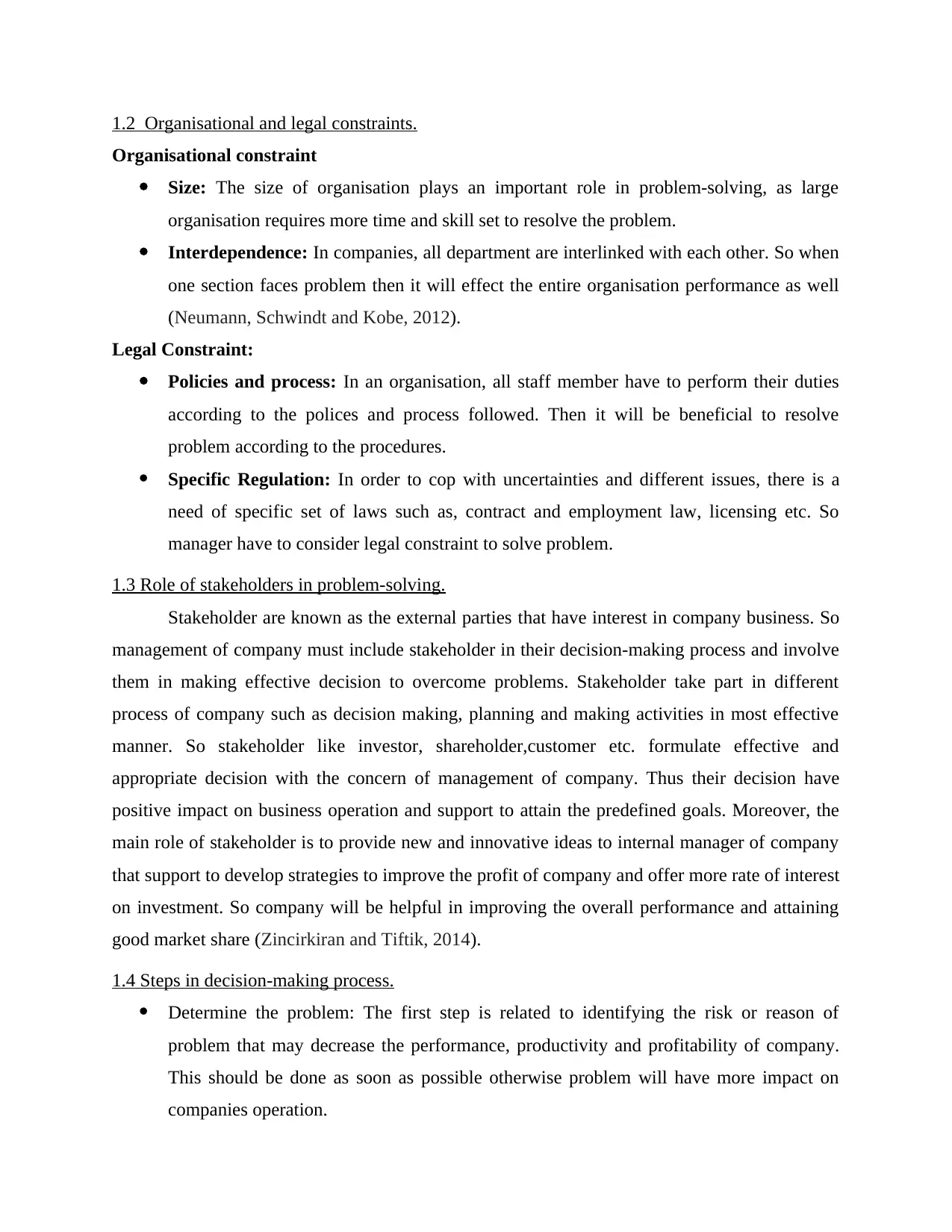
1.2 Organisational and legal constraints.
Organisational constraint
Size: The size of organisation plays an important role in problem-solving, as large
organisation requires more time and skill set to resolve the problem.
Interdependence: In companies, all department are interlinked with each other. So when
one section faces problem then it will effect the entire organisation performance as well
(Neumann, Schwindt and Kobe, 2012).
Legal Constraint:
Policies and process: In an organisation, all staff member have to perform their duties
according to the polices and process followed. Then it will be beneficial to resolve
problem according to the procedures.
Specific Regulation: In order to cop with uncertainties and different issues, there is a
need of specific set of laws such as, contract and employment law, licensing etc. So
manager have to consider legal constraint to solve problem.
1.3 Role of stakeholders in problem-solving.
Stakeholder are known as the external parties that have interest in company business. So
management of company must include stakeholder in their decision-making process and involve
them in making effective decision to overcome problems. Stakeholder take part in different
process of company such as decision making, planning and making activities in most effective
manner. So stakeholder like investor, shareholder,customer etc. formulate effective and
appropriate decision with the concern of management of company. Thus their decision have
positive impact on business operation and support to attain the predefined goals. Moreover, the
main role of stakeholder is to provide new and innovative ideas to internal manager of company
that support to develop strategies to improve the profit of company and offer more rate of interest
on investment. So company will be helpful in improving the overall performance and attaining
good market share (Zincirkiran and Tiftik, 2014).
1.4 Steps in decision-making process.
Determine the problem: The first step is related to identifying the risk or reason of
problem that may decrease the performance, productivity and profitability of company.
This should be done as soon as possible otherwise problem will have more impact on
companies operation.
Organisational constraint
Size: The size of organisation plays an important role in problem-solving, as large
organisation requires more time and skill set to resolve the problem.
Interdependence: In companies, all department are interlinked with each other. So when
one section faces problem then it will effect the entire organisation performance as well
(Neumann, Schwindt and Kobe, 2012).
Legal Constraint:
Policies and process: In an organisation, all staff member have to perform their duties
according to the polices and process followed. Then it will be beneficial to resolve
problem according to the procedures.
Specific Regulation: In order to cop with uncertainties and different issues, there is a
need of specific set of laws such as, contract and employment law, licensing etc. So
manager have to consider legal constraint to solve problem.
1.3 Role of stakeholders in problem-solving.
Stakeholder are known as the external parties that have interest in company business. So
management of company must include stakeholder in their decision-making process and involve
them in making effective decision to overcome problems. Stakeholder take part in different
process of company such as decision making, planning and making activities in most effective
manner. So stakeholder like investor, shareholder,customer etc. formulate effective and
appropriate decision with the concern of management of company. Thus their decision have
positive impact on business operation and support to attain the predefined goals. Moreover, the
main role of stakeholder is to provide new and innovative ideas to internal manager of company
that support to develop strategies to improve the profit of company and offer more rate of interest
on investment. So company will be helpful in improving the overall performance and attaining
good market share (Zincirkiran and Tiftik, 2014).
1.4 Steps in decision-making process.
Determine the problem: The first step is related to identifying the risk or reason of
problem that may decrease the performance, productivity and profitability of company.
This should be done as soon as possible otherwise problem will have more impact on
companies operation.
Secure Best Marks with AI Grader
Need help grading? Try our AI Grader for instant feedback on your assignments.
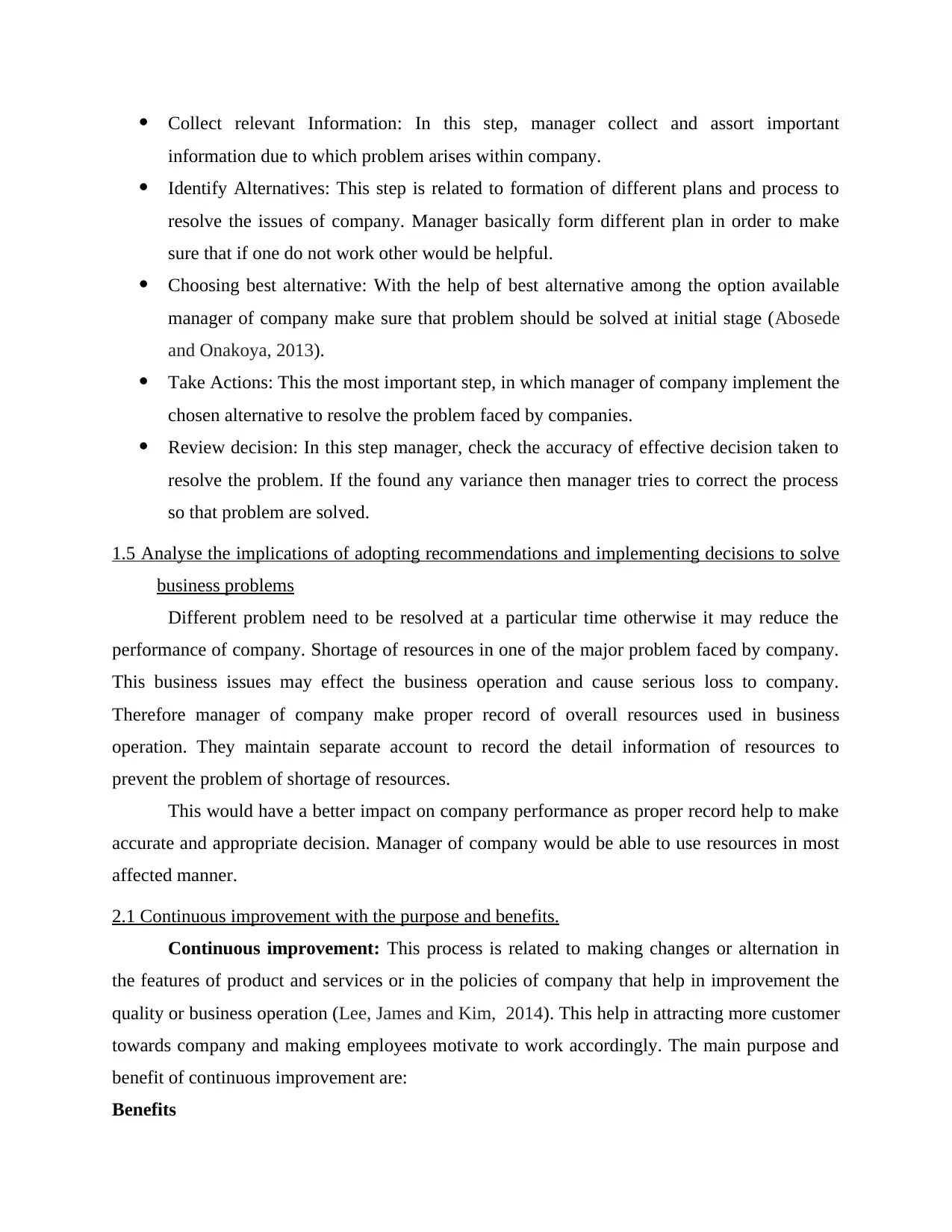
Collect relevant Information: In this step, manager collect and assort important
information due to which problem arises within company.
Identify Alternatives: This step is related to formation of different plans and process to
resolve the issues of company. Manager basically form different plan in order to make
sure that if one do not work other would be helpful.
Choosing best alternative: With the help of best alternative among the option available
manager of company make sure that problem should be solved at initial stage (Abosede
and Onakoya, 2013).
Take Actions: This the most important step, in which manager of company implement the
chosen alternative to resolve the problem faced by companies.
Review decision: In this step manager, check the accuracy of effective decision taken to
resolve the problem. If the found any variance then manager tries to correct the process
so that problem are solved.
1.5 Analyse the implications of adopting recommendations and implementing decisions to solve
business problems
Different problem need to be resolved at a particular time otherwise it may reduce the
performance of company. Shortage of resources in one of the major problem faced by company.
This business issues may effect the business operation and cause serious loss to company.
Therefore manager of company make proper record of overall resources used in business
operation. They maintain separate account to record the detail information of resources to
prevent the problem of shortage of resources.
This would have a better impact on company performance as proper record help to make
accurate and appropriate decision. Manager of company would be able to use resources in most
affected manner.
2.1 Continuous improvement with the purpose and benefits.
Continuous improvement: This process is related to making changes or alternation in
the features of product and services or in the policies of company that help in improvement the
quality or business operation (Lee, James and Kim, 2014). This help in attracting more customer
towards company and making employees motivate to work accordingly. The main purpose and
benefit of continuous improvement are:
Benefits
information due to which problem arises within company.
Identify Alternatives: This step is related to formation of different plans and process to
resolve the issues of company. Manager basically form different plan in order to make
sure that if one do not work other would be helpful.
Choosing best alternative: With the help of best alternative among the option available
manager of company make sure that problem should be solved at initial stage (Abosede
and Onakoya, 2013).
Take Actions: This the most important step, in which manager of company implement the
chosen alternative to resolve the problem faced by companies.
Review decision: In this step manager, check the accuracy of effective decision taken to
resolve the problem. If the found any variance then manager tries to correct the process
so that problem are solved.
1.5 Analyse the implications of adopting recommendations and implementing decisions to solve
business problems
Different problem need to be resolved at a particular time otherwise it may reduce the
performance of company. Shortage of resources in one of the major problem faced by company.
This business issues may effect the business operation and cause serious loss to company.
Therefore manager of company make proper record of overall resources used in business
operation. They maintain separate account to record the detail information of resources to
prevent the problem of shortage of resources.
This would have a better impact on company performance as proper record help to make
accurate and appropriate decision. Manager of company would be able to use resources in most
affected manner.
2.1 Continuous improvement with the purpose and benefits.
Continuous improvement: This process is related to making changes or alternation in
the features of product and services or in the policies of company that help in improvement the
quality or business operation (Lee, James and Kim, 2014). This help in attracting more customer
towards company and making employees motivate to work accordingly. The main purpose and
benefit of continuous improvement are:
Benefits
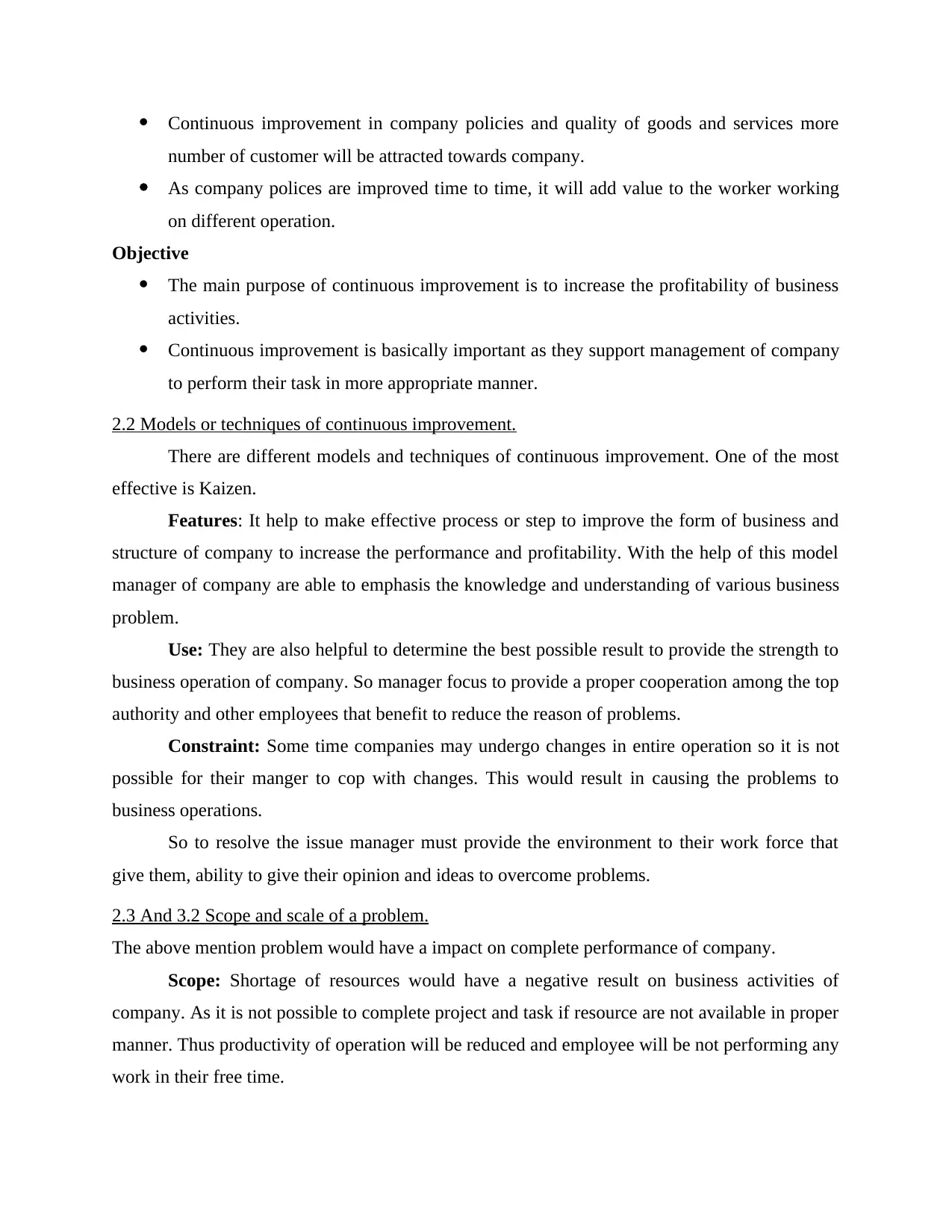
Continuous improvement in company policies and quality of goods and services more
number of customer will be attracted towards company.
As company polices are improved time to time, it will add value to the worker working
on different operation.
Objective
The main purpose of continuous improvement is to increase the profitability of business
activities.
Continuous improvement is basically important as they support management of company
to perform their task in more appropriate manner.
2.2 Models or techniques of continuous improvement.
There are different models and techniques of continuous improvement. One of the most
effective is Kaizen.
Features: It help to make effective process or step to improve the form of business and
structure of company to increase the performance and profitability. With the help of this model
manager of company are able to emphasis the knowledge and understanding of various business
problem.
Use: They are also helpful to determine the best possible result to provide the strength to
business operation of company. So manager focus to provide a proper cooperation among the top
authority and other employees that benefit to reduce the reason of problems.
Constraint: Some time companies may undergo changes in entire operation so it is not
possible for their manger to cop with changes. This would result in causing the problems to
business operations.
So to resolve the issue manager must provide the environment to their work force that
give them, ability to give their opinion and ideas to overcome problems.
2.3 And 3.2 Scope and scale of a problem.
The above mention problem would have a impact on complete performance of company.
Scope: Shortage of resources would have a negative result on business activities of
company. As it is not possible to complete project and task if resource are not available in proper
manner. Thus productivity of operation will be reduced and employee will be not performing any
work in their free time.
number of customer will be attracted towards company.
As company polices are improved time to time, it will add value to the worker working
on different operation.
Objective
The main purpose of continuous improvement is to increase the profitability of business
activities.
Continuous improvement is basically important as they support management of company
to perform their task in more appropriate manner.
2.2 Models or techniques of continuous improvement.
There are different models and techniques of continuous improvement. One of the most
effective is Kaizen.
Features: It help to make effective process or step to improve the form of business and
structure of company to increase the performance and profitability. With the help of this model
manager of company are able to emphasis the knowledge and understanding of various business
problem.
Use: They are also helpful to determine the best possible result to provide the strength to
business operation of company. So manager focus to provide a proper cooperation among the top
authority and other employees that benefit to reduce the reason of problems.
Constraint: Some time companies may undergo changes in entire operation so it is not
possible for their manger to cop with changes. This would result in causing the problems to
business operations.
So to resolve the issue manager must provide the environment to their work force that
give them, ability to give their opinion and ideas to overcome problems.
2.3 And 3.2 Scope and scale of a problem.
The above mention problem would have a impact on complete performance of company.
Scope: Shortage of resources would have a negative result on business activities of
company. As it is not possible to complete project and task if resource are not available in proper
manner. Thus productivity of operation will be reduced and employee will be not performing any
work in their free time.
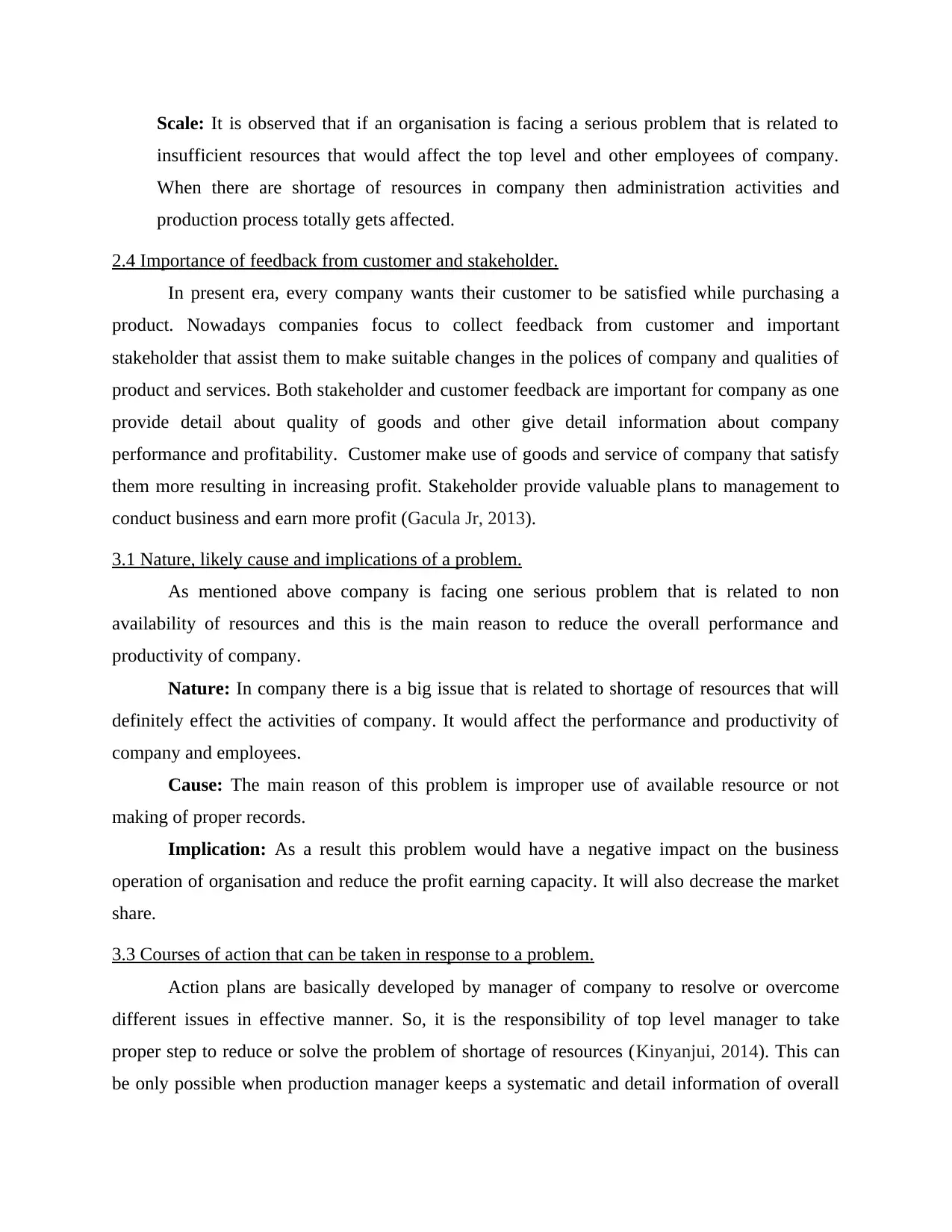
Scale: It is observed that if an organisation is facing a serious problem that is related to
insufficient resources that would affect the top level and other employees of company.
When there are shortage of resources in company then administration activities and
production process totally gets affected.
2.4 Importance of feedback from customer and stakeholder.
In present era, every company wants their customer to be satisfied while purchasing a
product. Nowadays companies focus to collect feedback from customer and important
stakeholder that assist them to make suitable changes in the polices of company and qualities of
product and services. Both stakeholder and customer feedback are important for company as one
provide detail about quality of goods and other give detail information about company
performance and profitability. Customer make use of goods and service of company that satisfy
them more resulting in increasing profit. Stakeholder provide valuable plans to management to
conduct business and earn more profit (Gacula Jr, 2013).
3.1 Nature, likely cause and implications of a problem.
As mentioned above company is facing one serious problem that is related to non
availability of resources and this is the main reason to reduce the overall performance and
productivity of company.
Nature: In company there is a big issue that is related to shortage of resources that will
definitely effect the activities of company. It would affect the performance and productivity of
company and employees.
Cause: The main reason of this problem is improper use of available resource or not
making of proper records.
Implication: As a result this problem would have a negative impact on the business
operation of organisation and reduce the profit earning capacity. It will also decrease the market
share.
3.3 Courses of action that can be taken in response to a problem.
Action plans are basically developed by manager of company to resolve or overcome
different issues in effective manner. So, it is the responsibility of top level manager to take
proper step to reduce or solve the problem of shortage of resources (Kinyanjui, 2014). This can
be only possible when production manager keeps a systematic and detail information of overall
insufficient resources that would affect the top level and other employees of company.
When there are shortage of resources in company then administration activities and
production process totally gets affected.
2.4 Importance of feedback from customer and stakeholder.
In present era, every company wants their customer to be satisfied while purchasing a
product. Nowadays companies focus to collect feedback from customer and important
stakeholder that assist them to make suitable changes in the polices of company and qualities of
product and services. Both stakeholder and customer feedback are important for company as one
provide detail about quality of goods and other give detail information about company
performance and profitability. Customer make use of goods and service of company that satisfy
them more resulting in increasing profit. Stakeholder provide valuable plans to management to
conduct business and earn more profit (Gacula Jr, 2013).
3.1 Nature, likely cause and implications of a problem.
As mentioned above company is facing one serious problem that is related to non
availability of resources and this is the main reason to reduce the overall performance and
productivity of company.
Nature: In company there is a big issue that is related to shortage of resources that will
definitely effect the activities of company. It would affect the performance and productivity of
company and employees.
Cause: The main reason of this problem is improper use of available resource or not
making of proper records.
Implication: As a result this problem would have a negative impact on the business
operation of organisation and reduce the profit earning capacity. It will also decrease the market
share.
3.3 Courses of action that can be taken in response to a problem.
Action plans are basically developed by manager of company to resolve or overcome
different issues in effective manner. So, it is the responsibility of top level manager to take
proper step to reduce or solve the problem of shortage of resources (Kinyanjui, 2014). This can
be only possible when production manager keeps a systematic and detail information of overall
Paraphrase This Document
Need a fresh take? Get an instant paraphrase of this document with our AI Paraphraser
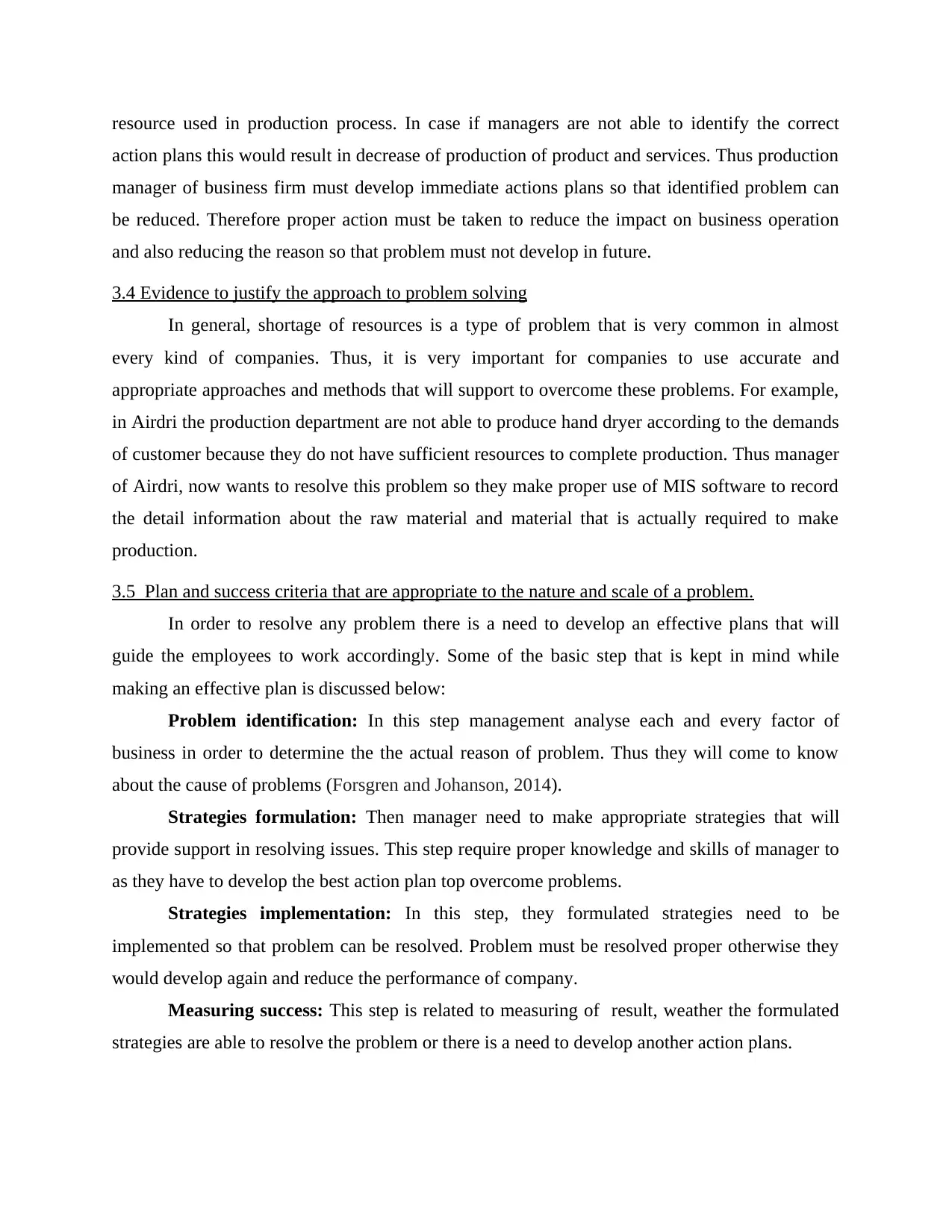
resource used in production process. In case if managers are not able to identify the correct
action plans this would result in decrease of production of product and services. Thus production
manager of business firm must develop immediate actions plans so that identified problem can
be reduced. Therefore proper action must be taken to reduce the impact on business operation
and also reducing the reason so that problem must not develop in future.
3.4 Evidence to justify the approach to problem solving
In general, shortage of resources is a type of problem that is very common in almost
every kind of companies. Thus, it is very important for companies to use accurate and
appropriate approaches and methods that will support to overcome these problems. For example,
in Airdri the production department are not able to produce hand dryer according to the demands
of customer because they do not have sufficient resources to complete production. Thus manager
of Airdri, now wants to resolve this problem so they make proper use of MIS software to record
the detail information about the raw material and material that is actually required to make
production.
3.5 Plan and success criteria that are appropriate to the nature and scale of a problem.
In order to resolve any problem there is a need to develop an effective plans that will
guide the employees to work accordingly. Some of the basic step that is kept in mind while
making an effective plan is discussed below:
Problem identification: In this step management analyse each and every factor of
business in order to determine the the actual reason of problem. Thus they will come to know
about the cause of problems (Forsgren and Johanson, 2014).
Strategies formulation: Then manager need to make appropriate strategies that will
provide support in resolving issues. This step require proper knowledge and skills of manager to
as they have to develop the best action plan top overcome problems.
Strategies implementation: In this step, they formulated strategies need to be
implemented so that problem can be resolved. Problem must be resolved proper otherwise they
would develop again and reduce the performance of company.
Measuring success: This step is related to measuring of result, weather the formulated
strategies are able to resolve the problem or there is a need to develop another action plans.
action plans this would result in decrease of production of product and services. Thus production
manager of business firm must develop immediate actions plans so that identified problem can
be reduced. Therefore proper action must be taken to reduce the impact on business operation
and also reducing the reason so that problem must not develop in future.
3.4 Evidence to justify the approach to problem solving
In general, shortage of resources is a type of problem that is very common in almost
every kind of companies. Thus, it is very important for companies to use accurate and
appropriate approaches and methods that will support to overcome these problems. For example,
in Airdri the production department are not able to produce hand dryer according to the demands
of customer because they do not have sufficient resources to complete production. Thus manager
of Airdri, now wants to resolve this problem so they make proper use of MIS software to record
the detail information about the raw material and material that is actually required to make
production.
3.5 Plan and success criteria that are appropriate to the nature and scale of a problem.
In order to resolve any problem there is a need to develop an effective plans that will
guide the employees to work accordingly. Some of the basic step that is kept in mind while
making an effective plan is discussed below:
Problem identification: In this step management analyse each and every factor of
business in order to determine the the actual reason of problem. Thus they will come to know
about the cause of problems (Forsgren and Johanson, 2014).
Strategies formulation: Then manager need to make appropriate strategies that will
provide support in resolving issues. This step require proper knowledge and skills of manager to
as they have to develop the best action plan top overcome problems.
Strategies implementation: In this step, they formulated strategies need to be
implemented so that problem can be resolved. Problem must be resolved proper otherwise they
would develop again and reduce the performance of company.
Measuring success: This step is related to measuring of result, weather the formulated
strategies are able to resolve the problem or there is a need to develop another action plans.
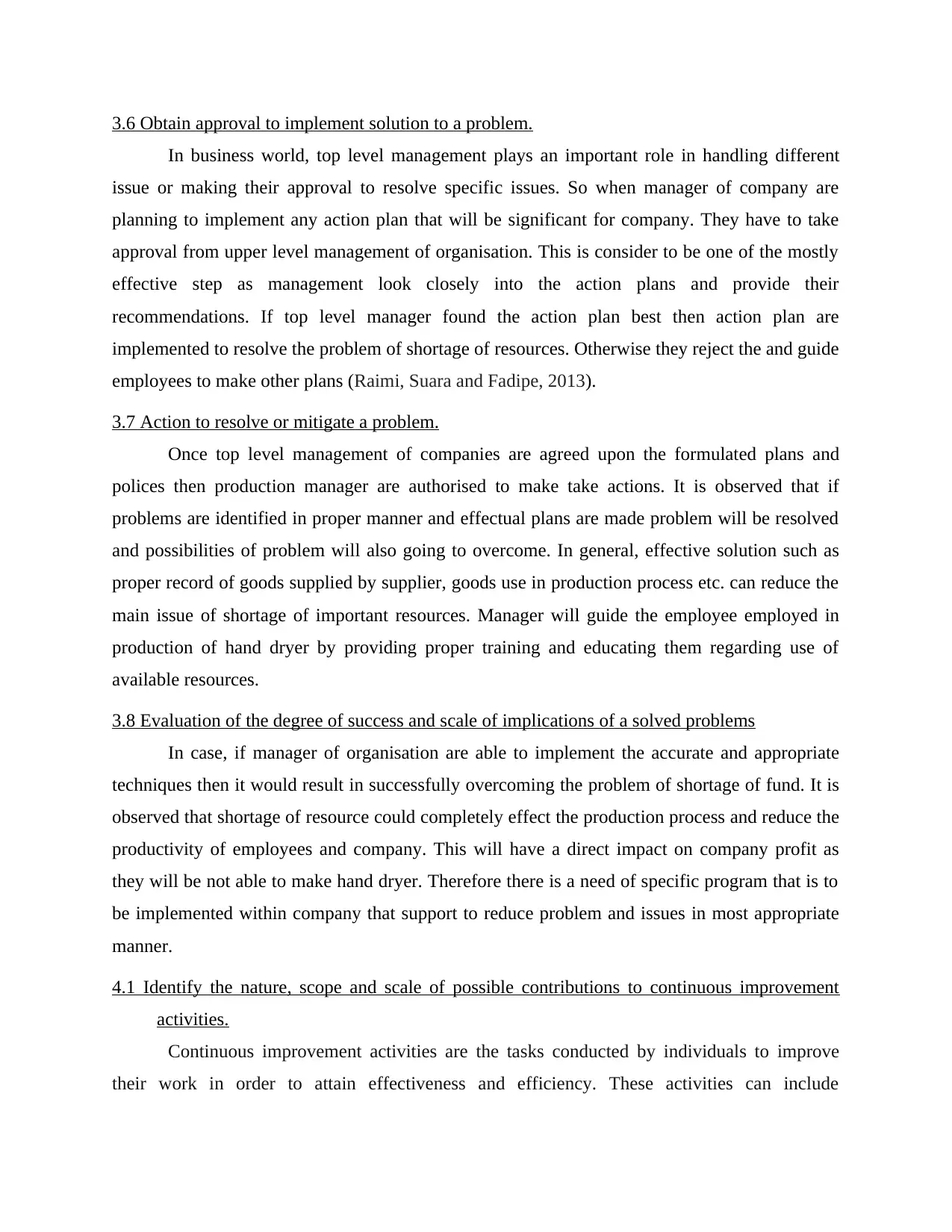
3.6 Obtain approval to implement solution to a problem.
In business world, top level management plays an important role in handling different
issue or making their approval to resolve specific issues. So when manager of company are
planning to implement any action plan that will be significant for company. They have to take
approval from upper level management of organisation. This is consider to be one of the mostly
effective step as management look closely into the action plans and provide their
recommendations. If top level manager found the action plan best then action plan are
implemented to resolve the problem of shortage of resources. Otherwise they reject the and guide
employees to make other plans (Raimi, Suara and Fadipe, 2013).
3.7 Action to resolve or mitigate a problem.
Once top level management of companies are agreed upon the formulated plans and
polices then production manager are authorised to make take actions. It is observed that if
problems are identified in proper manner and effectual plans are made problem will be resolved
and possibilities of problem will also going to overcome. In general, effective solution such as
proper record of goods supplied by supplier, goods use in production process etc. can reduce the
main issue of shortage of important resources. Manager will guide the employee employed in
production of hand dryer by providing proper training and educating them regarding use of
available resources.
3.8 Evaluation of the degree of success and scale of implications of a solved problems
In case, if manager of organisation are able to implement the accurate and appropriate
techniques then it would result in successfully overcoming the problem of shortage of fund. It is
observed that shortage of resource could completely effect the production process and reduce the
productivity of employees and company. This will have a direct impact on company profit as
they will be not able to make hand dryer. Therefore there is a need of specific program that is to
be implemented within company that support to reduce problem and issues in most appropriate
manner.
4.1 Identify the nature, scope and scale of possible contributions to continuous improvement
activities.
Continuous improvement activities are the tasks conducted by individuals to improve
their work in order to attain effectiveness and efficiency. These activities can include
In business world, top level management plays an important role in handling different
issue or making their approval to resolve specific issues. So when manager of company are
planning to implement any action plan that will be significant for company. They have to take
approval from upper level management of organisation. This is consider to be one of the mostly
effective step as management look closely into the action plans and provide their
recommendations. If top level manager found the action plan best then action plan are
implemented to resolve the problem of shortage of resources. Otherwise they reject the and guide
employees to make other plans (Raimi, Suara and Fadipe, 2013).
3.7 Action to resolve or mitigate a problem.
Once top level management of companies are agreed upon the formulated plans and
polices then production manager are authorised to make take actions. It is observed that if
problems are identified in proper manner and effectual plans are made problem will be resolved
and possibilities of problem will also going to overcome. In general, effective solution such as
proper record of goods supplied by supplier, goods use in production process etc. can reduce the
main issue of shortage of important resources. Manager will guide the employee employed in
production of hand dryer by providing proper training and educating them regarding use of
available resources.
3.8 Evaluation of the degree of success and scale of implications of a solved problems
In case, if manager of organisation are able to implement the accurate and appropriate
techniques then it would result in successfully overcoming the problem of shortage of fund. It is
observed that shortage of resource could completely effect the production process and reduce the
productivity of employees and company. This will have a direct impact on company profit as
they will be not able to make hand dryer. Therefore there is a need of specific program that is to
be implemented within company that support to reduce problem and issues in most appropriate
manner.
4.1 Identify the nature, scope and scale of possible contributions to continuous improvement
activities.
Continuous improvement activities are the tasks conducted by individuals to improve
their work in order to attain effectiveness and efficiency. These activities can include
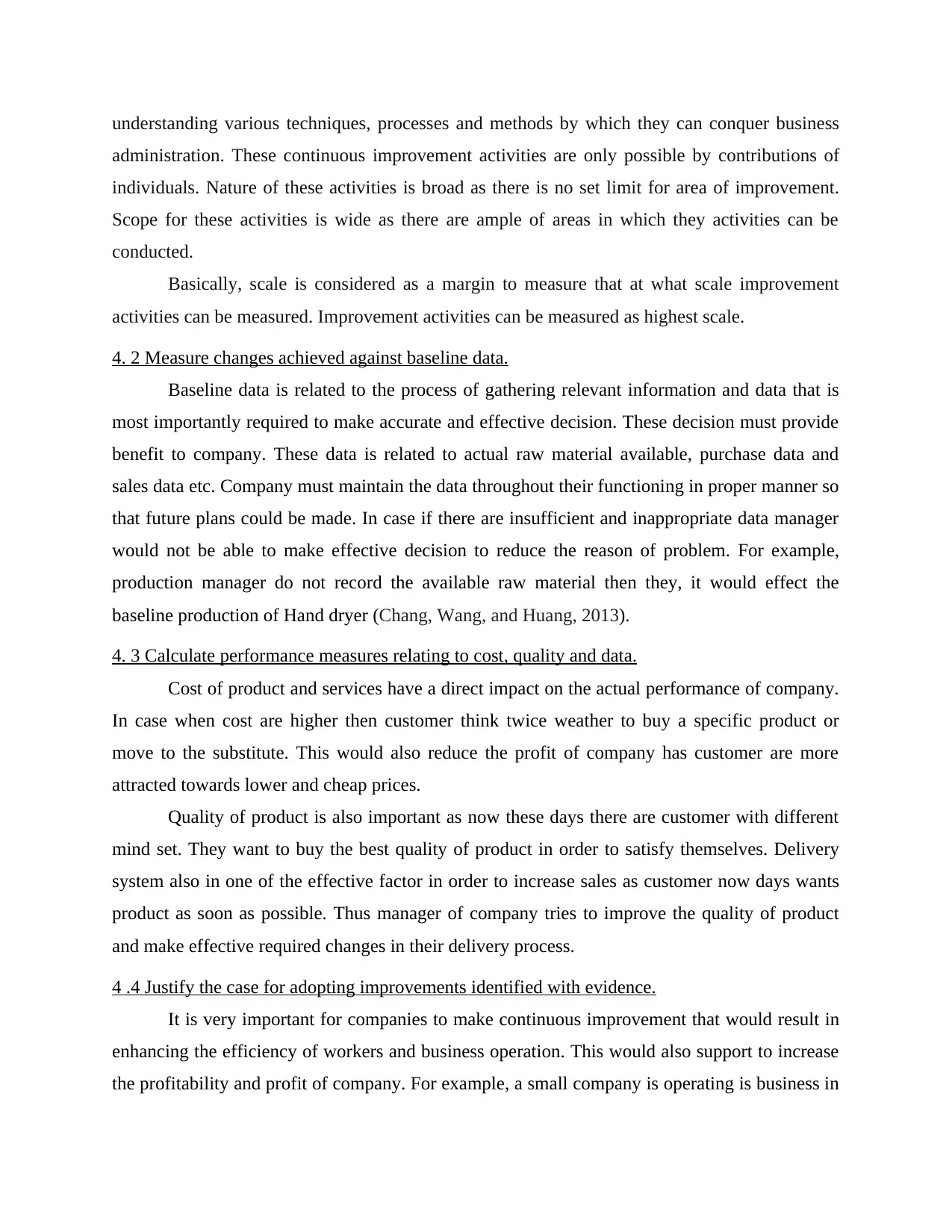
understanding various techniques, processes and methods by which they can conquer business
administration. These continuous improvement activities are only possible by contributions of
individuals. Nature of these activities is broad as there is no set limit for area of improvement.
Scope for these activities is wide as there are ample of areas in which they activities can be
conducted.
Basically, scale is considered as a margin to measure that at what scale improvement
activities can be measured. Improvement activities can be measured as highest scale.
4. 2 Measure changes achieved against baseline data.
Baseline data is related to the process of gathering relevant information and data that is
most importantly required to make accurate and effective decision. These decision must provide
benefit to company. These data is related to actual raw material available, purchase data and
sales data etc. Company must maintain the data throughout their functioning in proper manner so
that future plans could be made. In case if there are insufficient and inappropriate data manager
would not be able to make effective decision to reduce the reason of problem. For example,
production manager do not record the available raw material then they, it would effect the
baseline production of Hand dryer (Chang, Wang, and Huang, 2013).
4. 3 Calculate performance measures relating to cost, quality and data.
Cost of product and services have a direct impact on the actual performance of company.
In case when cost are higher then customer think twice weather to buy a specific product or
move to the substitute. This would also reduce the profit of company has customer are more
attracted towards lower and cheap prices.
Quality of product is also important as now these days there are customer with different
mind set. They want to buy the best quality of product in order to satisfy themselves. Delivery
system also in one of the effective factor in order to increase sales as customer now days wants
product as soon as possible. Thus manager of company tries to improve the quality of product
and make effective required changes in their delivery process.
4 .4 Justify the case for adopting improvements identified with evidence.
It is very important for companies to make continuous improvement that would result in
enhancing the efficiency of workers and business operation. This would also support to increase
the profitability and profit of company. For example, a small company is operating is business in
administration. These continuous improvement activities are only possible by contributions of
individuals. Nature of these activities is broad as there is no set limit for area of improvement.
Scope for these activities is wide as there are ample of areas in which they activities can be
conducted.
Basically, scale is considered as a margin to measure that at what scale improvement
activities can be measured. Improvement activities can be measured as highest scale.
4. 2 Measure changes achieved against baseline data.
Baseline data is related to the process of gathering relevant information and data that is
most importantly required to make accurate and effective decision. These decision must provide
benefit to company. These data is related to actual raw material available, purchase data and
sales data etc. Company must maintain the data throughout their functioning in proper manner so
that future plans could be made. In case if there are insufficient and inappropriate data manager
would not be able to make effective decision to reduce the reason of problem. For example,
production manager do not record the available raw material then they, it would effect the
baseline production of Hand dryer (Chang, Wang, and Huang, 2013).
4. 3 Calculate performance measures relating to cost, quality and data.
Cost of product and services have a direct impact on the actual performance of company.
In case when cost are higher then customer think twice weather to buy a specific product or
move to the substitute. This would also reduce the profit of company has customer are more
attracted towards lower and cheap prices.
Quality of product is also important as now these days there are customer with different
mind set. They want to buy the best quality of product in order to satisfy themselves. Delivery
system also in one of the effective factor in order to increase sales as customer now days wants
product as soon as possible. Thus manager of company tries to improve the quality of product
and make effective required changes in their delivery process.
4 .4 Justify the case for adopting improvements identified with evidence.
It is very important for companies to make continuous improvement that would result in
enhancing the efficiency of workers and business operation. This would also support to increase
the profitability and profit of company. For example, a small company is operating is business in
Secure Best Marks with AI Grader
Need help grading? Try our AI Grader for instant feedback on your assignments.
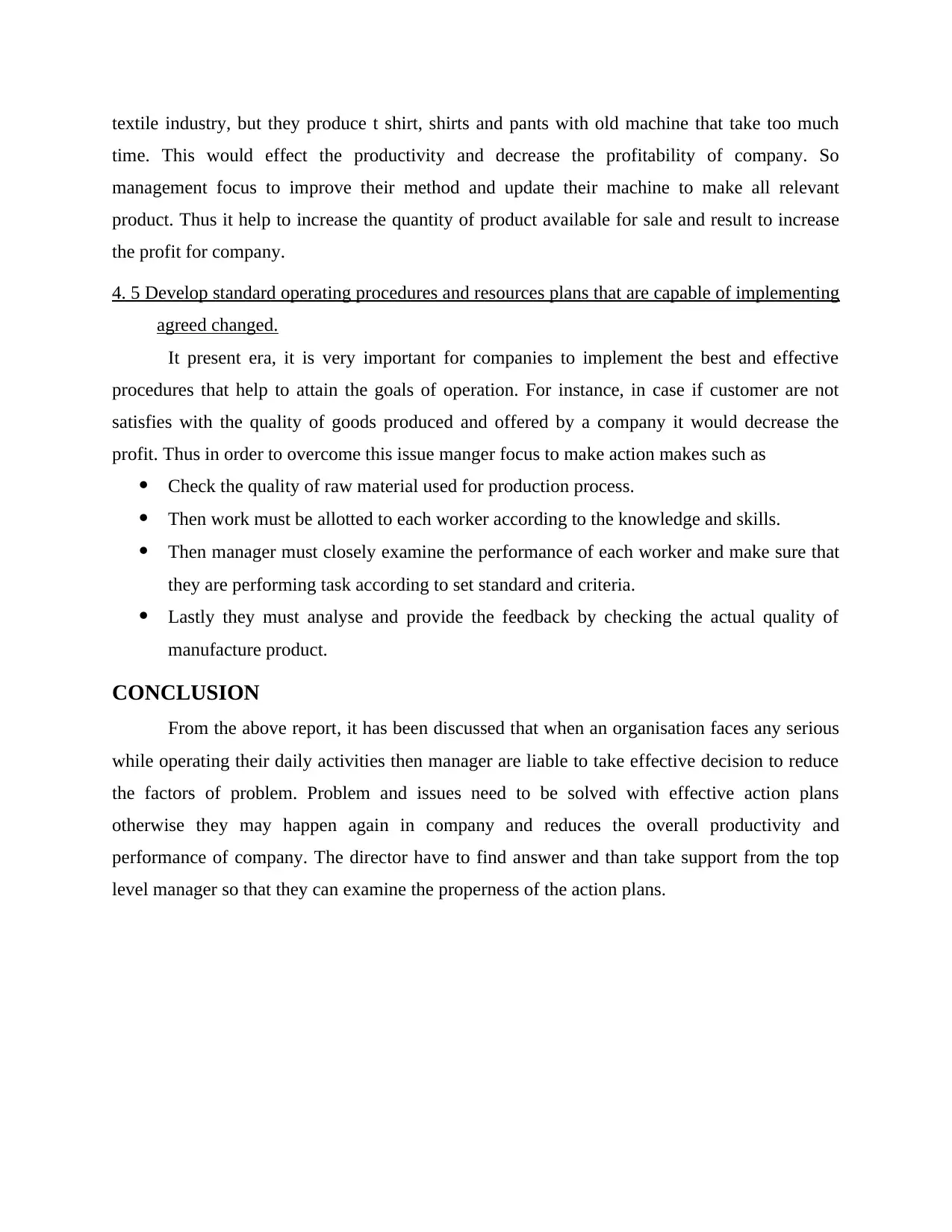
textile industry, but they produce t shirt, shirts and pants with old machine that take too much
time. This would effect the productivity and decrease the profitability of company. So
management focus to improve their method and update their machine to make all relevant
product. Thus it help to increase the quantity of product available for sale and result to increase
the profit for company.
4. 5 Develop standard operating procedures and resources plans that are capable of implementing
agreed changed.
It present era, it is very important for companies to implement the best and effective
procedures that help to attain the goals of operation. For instance, in case if customer are not
satisfies with the quality of goods produced and offered by a company it would decrease the
profit. Thus in order to overcome this issue manger focus to make action makes such as
Check the quality of raw material used for production process.
Then work must be allotted to each worker according to the knowledge and skills.
Then manager must closely examine the performance of each worker and make sure that
they are performing task according to set standard and criteria.
Lastly they must analyse and provide the feedback by checking the actual quality of
manufacture product.
CONCLUSION
From the above report, it has been discussed that when an organisation faces any serious
while operating their daily activities then manager are liable to take effective decision to reduce
the factors of problem. Problem and issues need to be solved with effective action plans
otherwise they may happen again in company and reduces the overall productivity and
performance of company. The director have to find answer and than take support from the top
level manager so that they can examine the properness of the action plans.
time. This would effect the productivity and decrease the profitability of company. So
management focus to improve their method and update their machine to make all relevant
product. Thus it help to increase the quantity of product available for sale and result to increase
the profit for company.
4. 5 Develop standard operating procedures and resources plans that are capable of implementing
agreed changed.
It present era, it is very important for companies to implement the best and effective
procedures that help to attain the goals of operation. For instance, in case if customer are not
satisfies with the quality of goods produced and offered by a company it would decrease the
profit. Thus in order to overcome this issue manger focus to make action makes such as
Check the quality of raw material used for production process.
Then work must be allotted to each worker according to the knowledge and skills.
Then manager must closely examine the performance of each worker and make sure that
they are performing task according to set standard and criteria.
Lastly they must analyse and provide the feedback by checking the actual quality of
manufacture product.
CONCLUSION
From the above report, it has been discussed that when an organisation faces any serious
while operating their daily activities then manager are liable to take effective decision to reduce
the factors of problem. Problem and issues need to be solved with effective action plans
otherwise they may happen again in company and reduces the overall productivity and
performance of company. The director have to find answer and than take support from the top
level manager so that they can examine the properness of the action plans.
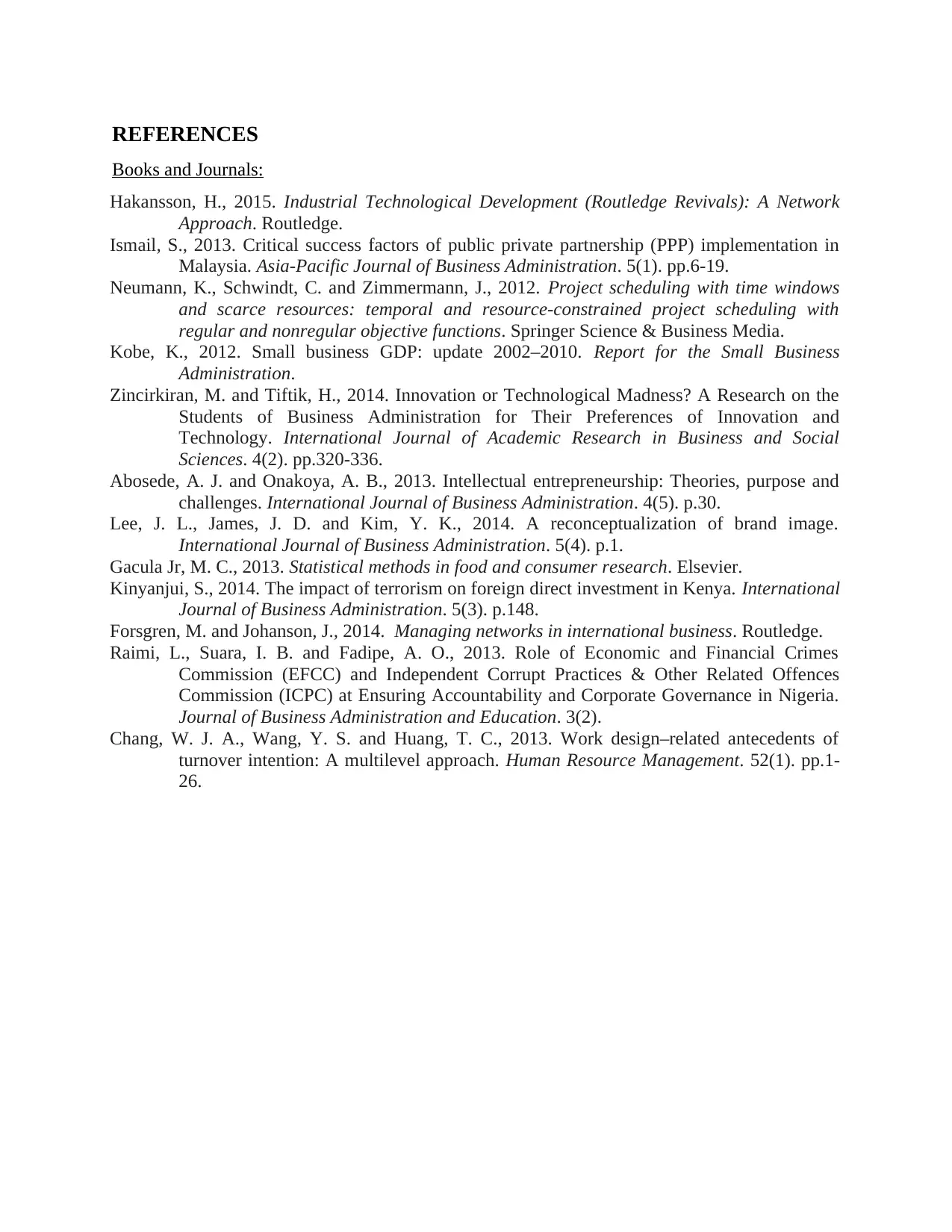
REFERENCES
Books and Journals:
Hakansson, H., 2015. Industrial Technological Development (Routledge Revivals): A Network
Approach. Routledge.
Ismail, S., 2013. Critical success factors of public private partnership (PPP) implementation in
Malaysia. Asia-Pacific Journal of Business Administration. 5(1). pp.6-19.
Neumann, K., Schwindt, C. and Zimmermann, J., 2012. Project scheduling with time windows
and scarce resources: temporal and resource-constrained project scheduling with
regular and nonregular objective functions. Springer Science & Business Media.
Kobe, K., 2012. Small business GDP: update 2002–2010. Report for the Small Business
Administration.
Zincirkiran, M. and Tiftik, H., 2014. Innovation or Technological Madness? A Research on the
Students of Business Administration for Their Preferences of Innovation and
Technology. International Journal of Academic Research in Business and Social
Sciences. 4(2). pp.320-336.
Abosede, A. J. and Onakoya, A. B., 2013. Intellectual entrepreneurship: Theories, purpose and
challenges. International Journal of Business Administration. 4(5). p.30.
Lee, J. L., James, J. D. and Kim, Y. K., 2014. A reconceptualization of brand image.
International Journal of Business Administration. 5(4). p.1.
Gacula Jr, M. C., 2013. Statistical methods in food and consumer research. Elsevier.
Kinyanjui, S., 2014. The impact of terrorism on foreign direct investment in Kenya. International
Journal of Business Administration. 5(3). p.148.
Forsgren, M. and Johanson, J., 2014. Managing networks in international business. Routledge.
Raimi, L., Suara, I. B. and Fadipe, A. O., 2013. Role of Economic and Financial Crimes
Commission (EFCC) and Independent Corrupt Practices & Other Related Offences
Commission (ICPC) at Ensuring Accountability and Corporate Governance in Nigeria.
Journal of Business Administration and Education. 3(2).
Chang, W. J. A., Wang, Y. S. and Huang, T. C., 2013. Work design–related antecedents of
turnover intention: A multilevel approach. Human Resource Management. 52(1). pp.1-
26.
Books and Journals:
Hakansson, H., 2015. Industrial Technological Development (Routledge Revivals): A Network
Approach. Routledge.
Ismail, S., 2013. Critical success factors of public private partnership (PPP) implementation in
Malaysia. Asia-Pacific Journal of Business Administration. 5(1). pp.6-19.
Neumann, K., Schwindt, C. and Zimmermann, J., 2012. Project scheduling with time windows
and scarce resources: temporal and resource-constrained project scheduling with
regular and nonregular objective functions. Springer Science & Business Media.
Kobe, K., 2012. Small business GDP: update 2002–2010. Report for the Small Business
Administration.
Zincirkiran, M. and Tiftik, H., 2014. Innovation or Technological Madness? A Research on the
Students of Business Administration for Their Preferences of Innovation and
Technology. International Journal of Academic Research in Business and Social
Sciences. 4(2). pp.320-336.
Abosede, A. J. and Onakoya, A. B., 2013. Intellectual entrepreneurship: Theories, purpose and
challenges. International Journal of Business Administration. 4(5). p.30.
Lee, J. L., James, J. D. and Kim, Y. K., 2014. A reconceptualization of brand image.
International Journal of Business Administration. 5(4). p.1.
Gacula Jr, M. C., 2013. Statistical methods in food and consumer research. Elsevier.
Kinyanjui, S., 2014. The impact of terrorism on foreign direct investment in Kenya. International
Journal of Business Administration. 5(3). p.148.
Forsgren, M. and Johanson, J., 2014. Managing networks in international business. Routledge.
Raimi, L., Suara, I. B. and Fadipe, A. O., 2013. Role of Economic and Financial Crimes
Commission (EFCC) and Independent Corrupt Practices & Other Related Offences
Commission (ICPC) at Ensuring Accountability and Corporate Governance in Nigeria.
Journal of Business Administration and Education. 3(2).
Chang, W. J. A., Wang, Y. S. and Huang, T. C., 2013. Work design–related antecedents of
turnover intention: A multilevel approach. Human Resource Management. 52(1). pp.1-
26.
1 out of 12
Related Documents
Your All-in-One AI-Powered Toolkit for Academic Success.
+13062052269
info@desklib.com
Available 24*7 on WhatsApp / Email
![[object Object]](/_next/static/media/star-bottom.7253800d.svg)
Unlock your academic potential
© 2024 | Zucol Services PVT LTD | All rights reserved.





